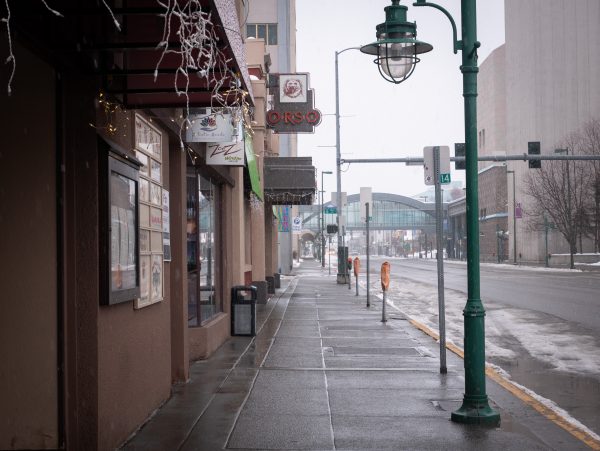
In 2019, Alaska emerged from the state’s longest recession on record. Things were looking up as jobs returned to the economy.
But then the pandemic derailed the recovery. The economic shock from widespread job losses and business closures was a huge setback.
“It’s important to note that doing an economic forecast during a pandemic is not an exercise that has been done too many times,” said Mouhcine Guettabi, an economist at the University of Alaska’s Institute of Social and Economic Research. “The level of uncertainty is just as big as I’ve ever seen it in my life.”
Despite the uncertainty, Guettabi laid out a forecast that shows the state’s economy returning to 95% of what it was pre-pandemic by the end of 2022. But that forecast relies on a number of factors that are susceptible to change.
To understand where the economy might be going, it’s important to talk about where it is now and how it got here.
Alaska saw its first case of COVID-19 on March 12. Since then, Guettabi says the state’s economy felt an unprecedented shock.
On March 17, Gov. Mike Dunleavy banned dine-in service at restaurants and bars statewide to slow the virus’s spread. The mandate also closed businesses like gyms, bowling alleys and movie theaters. Thousands of Alaskans were laid off, and not all small businesses have been able to reopen since the mandate was lifted.
At the same time, oil prices were plummeting and the promise of a record number of summer tourists began to disappear. Oil prices have since stabilized somewhat.
Rock bottom, Guettabi says, likely came sometime around late April.
Thousands of Alaskans continue to receive unemployment.
In an effort to offset these economic blows, a lot of money has been put back into the economy. The federal government distributed relief checks, boosted unemployment benefits and offered loans to small businesses. In Alaska, Permanent Fund Dividend checks were distributed months early, on July 1.
Between business closures and hunker down orders, the virus was spreading really slowly for a while. Businesses started reopening, and people began spending again. But soon, COVID-19 was spreading faster and further.
“We have more people going into shops, we have more people spending money. However, the re-emergence or the resurgence of the virus has kind of slowed that recovery back down as well,” said Guettabi.
Guettabi says as COVID numbers grow, people may choose to go out less and spend less money.
While he’s not an epidemiologist, Guettabi thinks the reopening of Alaska’s economy was likely premature.
“Getting the virus under control is the best remedy for the economy,” said Guettabi. “I think that remains the case, so, I think being prudent and closing for an additional month and being done with the virus or being in a place where people feel confident would have been the ideal scenario. I still remain – to me, it still remains very clear that businesses cannot handle multiple waves of closures.”
While we have yet to see another wave of state or locally-mandated closures, several businesses have closed at least temporarily because of employees or customers testing positive for the virus.
COVID-19 cases are surging, particularly in Anchorage, Alaska’s largest city.
If that’s where we are in July 2020, how will the economy return to 95% of pre-pandemic levels by the end of 2022? Guettabi’s forecast makes a few key assumptions.
First, more federal aid.
The federal government has been providing an extra $600 a week for recipients of unemployment. But that boost will soon expire.
“All the spending that we were seeing in the economy in the last month-and-a-half, that was due in no small part because of the generous federal UI payments,” said Guettabi.
Guettabi’s forecast also assumes that travel normalizes toward the end of 2021.
Still, there’s so much uncertainty around COVID-19 itself: when will a vaccine be available? Will there be a resurgence of the virus? More closures? Less aid?
Guettabi says one thing is for sure: this is not going to be a v-shaped recovery, where the economy just bounces back to normal.
“This is going to be a slow grind to get back to pre-pandemic levels,” said Guettabi.
And, even if we do get back to 95% of the state’s pre-pandemic economy by the end of 2022, that’s still around 15,000 fewer jobs.
